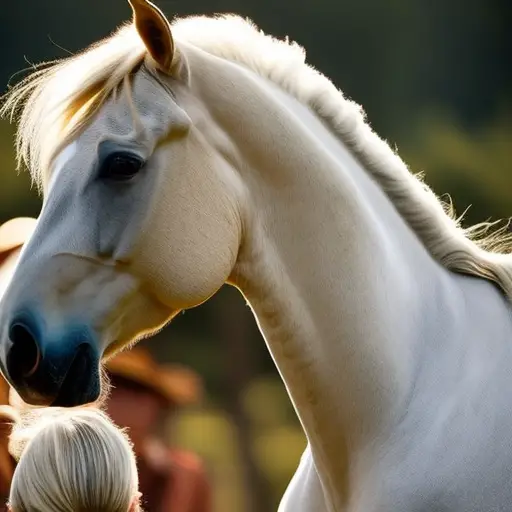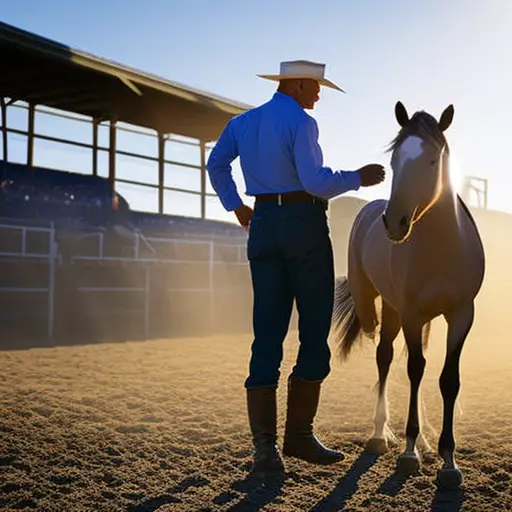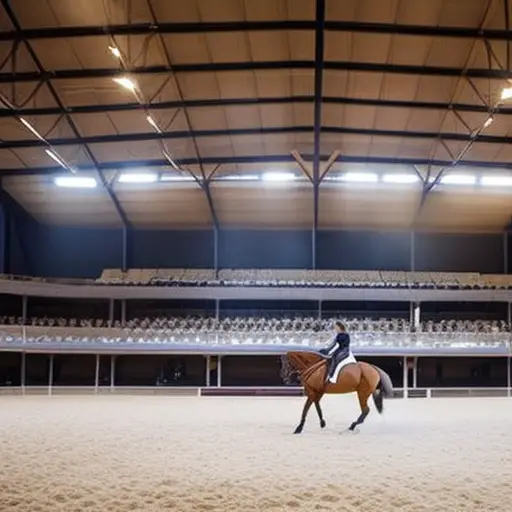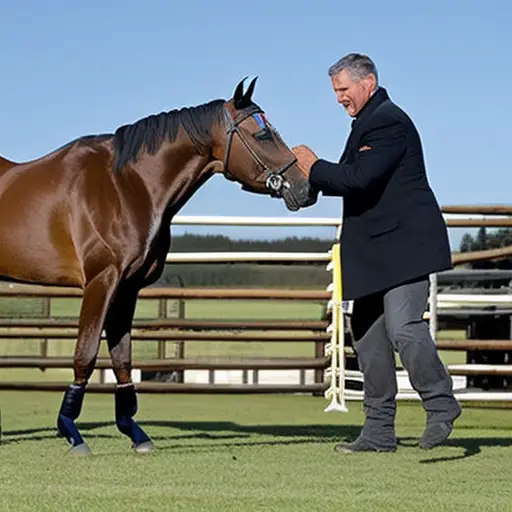Developing a Strong Rider-Horse Bond: Tips and Strategies

Are you ready to embark on a journey of connection and trust with your equine partner?
In this article, we will guide you through practical tips and strategies to develop a strong rider-horse bond.
From understanding their nature and behavior to effective communication in the saddle, we’ll show you how to create a safe and supportive environment for growth.
Get ready to deepen your relationship, overcome challenges, and experience the joy of a truly connected partnership.
Understanding the Horse’s Nature and Behavior
You should regularly observe and interact with your horse to gain a deeper understanding of its nature and behavior. By doing so, you can develop a stronger bond and improve your horse training techniques.
Understanding equine instincts is crucial in establishing effective communication and building trust with your horse. Additionally, learning about equine instincts can greatly enhance your understanding of your horse’s behavior. Horses are prey animals with strong flight instincts. They rely on their senses to survive in the wild. Understanding their natural instincts will help you tailor your training methods to their unique needs.
Observation is key when it comes to understanding your horse’s nature. Take the time to watch how your horse interacts with other horses in the pasture or during feeding time. Notice their body language, facial expressions, and overall demeanor. This will give you valuable insights into their social hierarchy, communication methods, and individual preferences.
Interacting with your horse on a daily basis is equally important. Spend quality time grooming, leading, and playing with your horse. This will help you establish a connection and build trust. Pay attention to how your horse responds to different cues and stimuli. This will give you a better understanding of their personality, fears, and motivations.
Building Trust Through Groundwork Exercises
To build trust with your horse through groundwork exercises, it’s essential to establish clear communication. By using cues and body language effectively, you can convey your intentions and expectations to your horse.
This will help create a mutual understanding between you and your horse, strengthening your partnership and connection.
Establishing Clear Communication
Building trust with your horse can be achieved by engaging in groundwork exercises that establish clear communication.
One of the most important aspects of establishing clear communication is understanding and utilizing body language. Horses are incredibly perceptive to nonverbal cues, so it’s crucial to be aware of your own body language and how it can affect your horse.
Practice maintaining a relaxed and confident posture, as this will help your horse feel more at ease and trust your leadership.
Additionally, incorporating trust building activities into your groundwork routine can further strengthen the bond between you and your horse. This can include exercises such as leading your horse over obstacles, desensitizing them to various stimuli, and teaching them to yield to pressure.
Building Mutual Understanding
Start by incorporating one or two groundwork exercises into your routine to build mutual understanding and trust with your horse. These exercises are essential for establishing a strong foundation and building a deep emotional connection with your equine partner.
Here are four effective exercises to help you develop a strong rider-horse bond:
-
Leading Exercises: Practice leading your horse in different environments to improve communication and understanding. Pay attention to your body language and use clear, consistent cues to guide your horse.
-
Desensitization: Gradually introduce your horse to various objects, sounds, and movements to build trust and confidence. Start with simple exercises and gradually increase the difficulty level.
-
Liberty Work: Engage in liberty work, where your horse is free from any physical constraints. This exercise encourages your horse to respond to your body language and strengthens the emotional connection between you.
-
Groundwork Patterns: Teach your horse specific patterns, such as circles, figure eights, and transitions, using groundwork exercises. This helps improve coordination, responsiveness, and understanding between you and your horse.
Strengthening Partnership and Connection
Improve your partnership and connection with your horse by engaging in groundwork exercises that focus on building trust and understanding. Building an emotional connection and enhancing body language are key elements in strengthening your bond with your horse. Groundwork exercises provide an opportunity for you to communicate with your horse on a deeper level and establish a foundation of trust and respect.
One effective exercise is the "join-up" technique, where you work with your horse in a round pen, using body language and energy to establish a connection. This exercise helps develop mutual trust and respect between you and your horse. Another exercise is the "desensitization" exercise, where you expose your horse to various objects and situations to help them overcome fear and build confidence.
By consistently practicing these groundwork exercises, you will build a strong partnership and connection with your horse, based on trust, understanding, and effective communication.
| Groundwork Exercises | Benefits |
|---|---|
| Join-up technique | Establishes trust and respect |
| Desensitization exercise | Builds confidence and trust |
Effective Communication in the Saddle
When it comes to effective communication in the saddle, non-verbal cues play a crucial role in conveying your intentions to your horse.
Clear aids, such as leg pressure and rein cues, are essential for effectively communicating your desired actions.
Non-Verbal Cues Importance
To establish a strong bond with your horse, it’s essential to understand the importance of non-verbal cues in effectively communicating while in the saddle. Horses are highly perceptive animals, and they rely heavily on body language to understand and respond to our cues.
Here are four key reasons why non-verbal cues are crucial:
-
Clear Communication: Non-verbal cues, such as subtle shifts in weight and leg pressure, provide clear instructions to your horse, allowing for precise movements and transitions.
-
Building Trust: Horses interpret body language as a signal of trust and leadership. By being aware of your own body language and using it effectively, you can establish a deeper level of trust with your horse.
-
Enhancing Connection: Non-verbal cues create a connection between you and your horse, fostering a sense of unity and cooperation. This connection is vital for achieving harmony and fluidity in your rides.
-
Non-Verbal Feedback: Horses are constantly providing us with non-verbal feedback through their body language. By understanding and responding to these cues, you can address any discomfort or issues your horse may be experiencing.
Clear Aids for Communication
For a stronger connection with your horse and better communication in the saddle, try using clear aids through consistent and precise cues. Developing trust with your horse is crucial in establishing effective communication. By reinforcing cues, you can ensure that your horse understands your intentions and responds accordingly. Clear aids involve using your body position, weight, legs, and hands to give signals to your horse. Consistency is key, as horses respond well to repetition and predictability. When giving cues, be sure to use the same aids each time to avoid confusion. Precise cues are also important, as horses can differentiate between subtle differences in your aids. By using clear aids, you can enhance your communication with your horse and strengthen your bond.
| AID | DESCRIPTION |
|---|---|
| Body Position | Align your body and sit tall to indicate direction and balance. |
| Weight | Shift your weight to communicate changes in speed and direction. |
| Legs | Use your legs to ask for forward movement, sideways movement, and changes in gait. |
| Hands | Use your hands to communicate turning, stopping, and changes in speed. |
Developing a Consistent Routine for Bonding
Try incorporating various activities into your daily routine to develop a consistent bond with your horse. Establishing consistent routines and developing a bonding ritual are essential for building a strong connection with your equine companion. Here are four practical tips to help you create a consistent routine for bonding:
-
Spend quality time together: Set aside dedicated time each day to interact with your horse. This could include grooming, hand grazing, or just spending time in their presence. By consistently showing up and engaging with your horse, you’ll strengthen your bond over time.
-
Create a feeding schedule: Horses thrive on routine, so establish a regular feeding schedule. Feeding your horse at the same time each day not only provides them with structure but also allows you to connect with them during meal times. Use this opportunity to interact with your horse by hand-feeding them or simply observing their behavior.
-
Practice consistent groundwork: Incorporate groundwork exercises into your routine to build trust and improve communication. This can include lunging, leading, or ground exercises that promote relaxation and responsiveness. Consistently working on these exercises will enhance your horse’s understanding of your cues and strengthen your bond.
-
Take regular rides or outings: Plan regular rides or outings with your horse to further solidify your bond. Whether it’s a trail ride, a lesson, or a fun play session in the arena, spending time in the saddle together helps develop trust and mutual understanding.
Incorporating Positive Reinforcement Techniques
Use rewards and praise to reinforce desired behaviors and strengthen the bond between you and your horse. Positive reinforcement techniques, such as clicker training, can be highly effective in communicating with your horse and building a strong relationship based on trust and understanding.
Clicker training is a form of positive reinforcement that involves using a clicker, a small handheld device that makes a distinct sound, to mark the desired behavior. When your horse performs the desired behavior, you immediately click the clicker and follow it with a treat or praise. This helps your horse associate the sound of the clicker with a positive outcome, encouraging them to repeat the behavior in the future.
To incorporate clicker training into your riding routine, start by introducing the clicker to your horse in a calm and relaxed environment. Click the clicker and immediately give your horse a treat or praise. Repeat this process several times until your horse understands that the clicker signifies a reward.
Once your horse is familiar with the clicker, you can start using it while riding. For example, if you want your horse to halt, click the clicker and reward them when they stop. Over time, your horse will learn to associate the clicker with the desired behavior and will respond accordingly.
Incorporating positive reinforcement techniques, such as clicker training, into your riding routine can greatly enhance your bond with your horse. By using rewards and praise to reinforce desired behaviors, you aren’t only creating a positive learning environment but also strengthening the trust and connection between you and your horse.
Overcoming Challenges and Building Resilience
To truly connect with your horse and build a strong bond, you need to push through obstacles and develop resilience. Overcoming setbacks and building emotional resilience is crucial for both you and your horse to grow and thrive in your partnership. Here are four essential tips to help you navigate challenges and build the resilience needed to strengthen your rider-horse bond:
-
Embrace a growth mindset: Instead of viewing setbacks as failures, see them as opportunities for growth and learning. Adopting a positive attitude and being open to new strategies will enable you to overcome obstacles more effectively.
-
Practice self-care: Taking care of yourself is essential for building emotional resilience. Make sure to prioritize your physical and mental well-being through activities such as exercise, meditation, and spending time with loved ones.
-
Seek support: Building resilience is easier when you have a strong support system. Surround yourself with like-minded individuals, such as fellow riders or trainers, who can provide encouragement, guidance, and perspective during challenging times.
-
Set realistic goals: Setbacks can be discouraging, but setting realistic goals can help you stay motivated and focused. Break down larger goals into smaller, attainable milestones, celebrating each achievement along the way.
Creating a Safe and Supportive Environment
To foster a strong bond between you and your horse, it’s important to establish a safe and supportive environment. Creating boundaries is essential to ensure both you and your horse feel secure and protected. Start by setting clear and consistent rules for behavior and reinforce them consistently. Horses thrive on routine and structure, so providing them with a predictable environment can help build trust and confidence in your partnership.
In addition to creating boundaries, it’s crucial to provide encouragement to your horse. Horses are sensitive creatures and respond positively to praise and rewards. When your horse does something well, whether it’s mastering a new skill or overcoming a fear, make sure to acknowledge and reward their efforts. This will reinforce positive behavior and motivate them to continue trying their best.
Creating a safe and supportive environment also means being aware of your horse’s physical and emotional well-being. Regularly checking for any signs of discomfort or illness, maintaining a clean and comfortable living space, and providing proper nutrition and exercise are all important aspects of horse care. By prioritizing your horse’s needs and ensuring they’re met, you’re creating an environment where they feel valued, loved, and supported.
Continual Learning and Growth in the Rider-Horse Relationship
As you progress in your journey with your horse, you’ll find that continual learning and growth are essential for deepening your rider-horse relationship. The bond you share with your horse can always be strengthened, and there are several techniques you can employ to ensure this continual growth.
Here are four continual learning techniques that can help you deepen your emotional connection with your horse:
-
Regular Training Sessions: Consistency is key when it comes to building a strong relationship with your horse. Schedule regular training sessions to work on new skills and reinforce existing ones. This won’t only improve your horse’s responsiveness but also enhance your communication and understanding.
-
Diversify Your Riding Activities: Explore different disciplines such as trail riding, jumping, or dressage. By exposing both yourself and your horse to new experiences, you’ll broaden your horizons and develop a more versatile partnership.
-
Seek Professional Guidance: Invest in lessons or clinics with experienced trainers. They can provide valuable insights, correct any errors in your riding technique, and introduce you to new training methods that can bring you closer to your horse.
-
Attend Workshops and Seminars: Continual learning shouldn’t be limited to practical training alone. Attend workshops and seminars that focus on horsemanship and equine behavior. These educational events can provide you with a deeper understanding of your horse’s needs and help you develop a more empathetic approach.
Frequently Asked Questions
How Can I Overcome My Fear of Riding and Build a Strong Bond With My Horse?
To overcome fear of riding and build a strong bond with your horse, start by gradually exposing yourself to riding activities. Engage in trust building activities, such as grooming and groundwork, to establish a foundation of trust and confidence.
What Are Some Common Challenges That Riders Face When Trying to Develop a Strong Bond With Their Horse?
Developing a strong bond with your horse can be challenging due to trust issues and communication barriers. Overcoming these obstacles requires patience, consistent training, and building a foundation of mutual respect and understanding.
How Can I Effectively Communicate With My Horse While in the Saddle?
To effectively communicate with your horse while in the saddle, use a combination of clear cues and body language. Building trust and understanding takes time and patience, but with practice, you’ll create a strong bond.
Are There Any Specific Exercises or Activities That Can Help Strengthen the Rider-Horse Bond?
To strengthen the rider-horse bond, engage in exercises and activities that promote trust and communication. Practice groundwork, such as leading and lunging, to build a solid foundation. Incorporate trail rides and obstacle courses to challenge and bond with your horse.
What Are Some Signs That Indicate a Strong and Healthy Bond Between a Rider and Their Horse?
You can tell that you have a strong and healthy bond with your horse when you both trust each other completely, communicate effortlessly, and work together harmoniously. Overcoming fear and building a bond takes time and patience.
Conclusion
In conclusion, developing a strong rider-horse bond requires understanding, trust, and effective communication.
By investing time in groundwork exercises, creating a consistent routine, and incorporating positive reinforcement techniques, you can build a resilient and supportive relationship with your horse.
Remember that continual learning and growth are essential for maintaining a strong bond.
With patience and dedication, you can create a safe and fulfilling partnership that will enhance both your riding experience and the emotional connection with your equine companion.

Join Davina Gardea on a journey into the world of horsemanship. With a deep passion for horses and years of experience, Davina shares invaluable insights and techniques to enhance your connection with these magnificent creatures. Explore the art of riding, training, and nurturing a profound bond with horses at diedgone.com.






